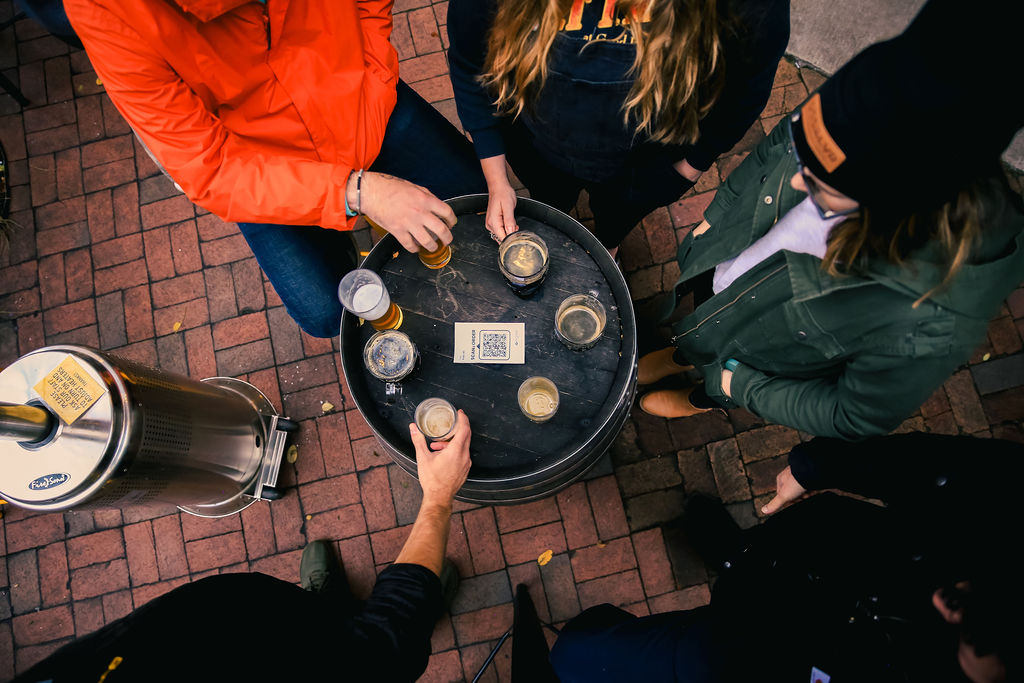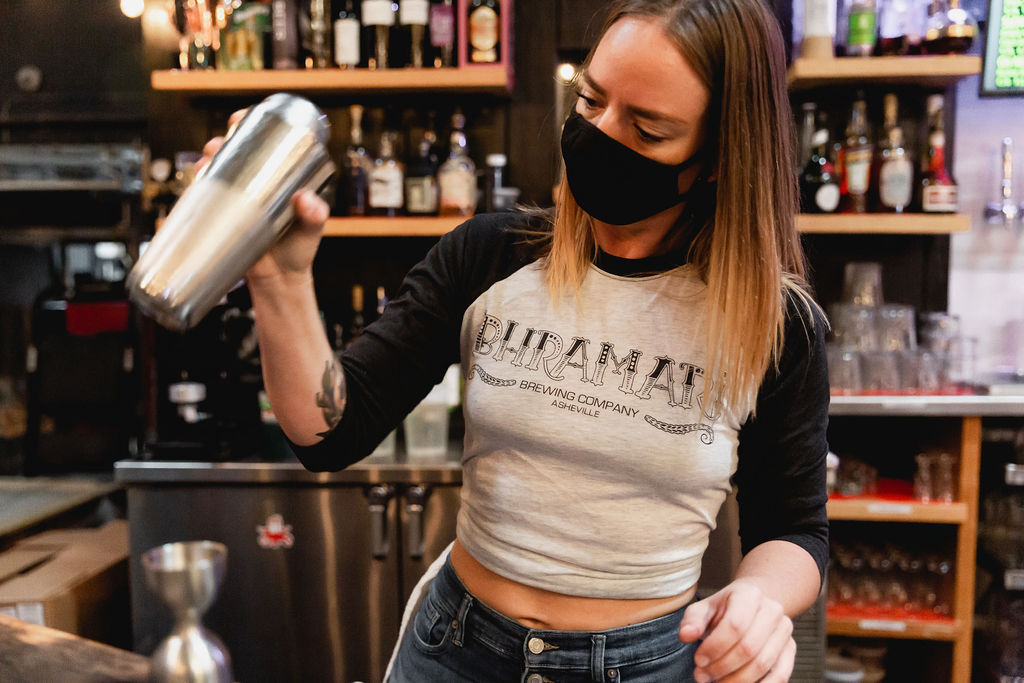Best POS System for Bars for Faster Service
Work faster with the help of your bar POS system. Check out these 5 tools to keep drinks flowing and guests smiling.

The speed at which a bar functions is arguably the most important quality of any given watering hole. That’s why the best POS system for bars is one that offers features that facilitate speedy service! Here are 5 tools to keep any eye out for to keep drinks flowing and guests smiling:
1. POS Devices
The devices themselves have a large effect on the speed of a bar’s service.
MOBILE, CLOUD-BASED
Mobile POS systems use smartphones and tablets as payment terminals, versus the stationary terminal and cash drawer that old school POS systems consist of. This kind of system lets bartenders better serve their customers by allowing them to travel around the bar and assist the next thirstiest guest. By being able to carry around the best POS system for bars in your back pocket, bartenders take orders and accept payments anywhere.
Checkout is a breeze with mobile devices, too. They are equipped to accept a wider variety of payment methods, such as credit/debit cards, contactless RFID cards, and digital wallets. By reducing friction in the closing out process, guests can swipe, tap, or dip, and get on their merry way to the next bar!
The cloud-based element of these POS devices also speeds things up for both staff and customers. Orders are entered into the cloud, meaning all orders instantly sync across all devices within a bar. That means the staff member pouring drinks or assembling plates receives the order as soon as it’s placed, cutting the time it takes for them to fulfill the order and get it into guests’ hands.
ORDERING INTERFACE
Smart technology for the best POS system for bars extends to the interface that staff interacts with. Afterall, if they’re struggling with tab functionalities, it slows down order inputs and they may miss an order from fast-talking guests.
- Modifiers: Sometimes, when an order is added to a tab, there is an immediate follow-up question for the guest. This could be what condiment they’d like with their order of fries, or whether they’d like salt on their margarita rim. The best POS system for bars put easy Modifier buttons in their ordering interface, so a bartender can quickly customize any guest’s order with a couple clicks.
- Add Another Round: Your bar is serving up the good stuff. So oftentimes, a table wants another round of whatever they just had. A function of the best POS system for bars is a Reorder button, which makes tacking on another round a simple process, even for a 15-person table!
- Split & Merge Tabs: Splitting and merging tabs can be a pain in the butt sometimes, especially for big tables, but smart POS systems make these requests fast with intuitive interface features.
- Tab Tags: This handy tool is perfect for organizing bars into groups. If a hockey team comes in for a few rounds of beers, bartenders can tag each of their tabs with a tag named “Hockey.” Then when someone in a jersey comes up to the bar in a few hours, a bartender can easily narrow down the open tabs to all Hockey ones, and find the appropriate tab to close out.
CARD ON FILE
We’ll let you in on a not-so-secret, secret: Everyone hates credit card rolodexes. Bartenders dread the responsibility of keeping precious credit cards behind the counter, and guests dislike the possibility of leaving their card behind.
That’s why the best POS system for bars offers card on file technology, where bartenders can swipe cards and hand them right back to guests. Tabs stay open and everyone involved stays stress-free!
2. Order Management
Cloud-based devices are indeed handy for expediting the ordering process and getting items to tables, but it also makes it quick and easy to manage menus and venues!
AUTOMATED MENU UPDATES
Digital menus are obviously much easier to update than printed ones. But the best POS system for bars also allows you to automate updates for recurring instances.
For example, timed menus can automatically update pricing for Happy Hour, and then revert back to regular prices once it ends. This eliminates guest confusion on pricing, and it’s a set-it-and-forget-it for staff!
This automation also helps with items that get sold out. The best POS system makes it easy to 86 sold-out stuff on menus, so guests never order items out of stock.
KITCHEN DISPLAY SYSTEM
For bars that offer food, a kitchen display system (KDS) is a great tool for kitchen staff to use to organize orders that come in, and get a holistic view of what’s needed from them. A KDS syncs with digital tickets and displays them in order of priority. This adds another layer of speed to getting plates out of the kitchen!
VENUE MANAGEMENT
If bars have separate front and back patios, a stage, and a main dining area, it’s a good idea to manage each of these venues separately. Perhaps the patios get plastic glassware and orders need to be differentiated to reflect that! The best POS system for bars makes it easy to manage this, and customize the layout of tables, bar stools, and outdoor seating available. This keeps staff organized and saves them time on ensuring there are no goofs.
3. Floating Service
Floating service is a service model hybrid between table and counter service. As you know, table service is costly to staff, and counter service has lower guest engagement opportunities. By combining the best of both worlds, you get a service model that allows you to work with a smaller staff and still surprise and delight your guests.
But floating service requires a trusty sidekick: the QR code. QR codes rapidly grew in popularity among bars nationwide during the peak of the pandemic as a socially distanced way to serve guests, but it’s continuing to be adopted because of how much it speeds up service.
So how does floating service work? Supported by the best POS system for bars, QR codes greet every guest at their seat. Guests can then scan the QR code to view the menu, open a tab, add as many menu items as they’d like, and even close out, all from their own smartphone! Their tabs sync with all staff devices in real-time, so a roaming server can input the next round themselves, or suggest the perfect snack pairing for their drinks.
Not only do QR codes totally rock guests’ worlds (ordering power in their own hands is frankly luxurious!) this technology also speeds up how quickly guests receive their orders. With kitchen and bar staff instantly receiving their orders, runners can bring them out in a snap.
If you’re interested in learning more about QR codes, how to implement floating service, and the best POS system for bars that support them, check out The Ultimate Guide to QR Codes for Bars for free!
4. Third-Party Integrations
Now it’s time to talk about how the best POS system for bars speed up processes for back of house staff. If you’re not familiar with integrations, they are third-party software applications that extend the functionality of your POS. Integrations connect POS software with other softwares that specialize in certain areas of business, making the best POS system for bars more capable, data-savvy, and yes, faster!
Here are some examples of integrations that work with the best POS system for bars:
INVENTORY MANAGEMENT
Tracking your depleted inventory is essential data to have at the ready at all times. How the best POS system for bars handles inventory and how that data flows into other systems is what might save BOH staff the most time on a daily basis. With all of that data syncing together, you can identify major business insights that would otherwise require hours of manual data entry and analysis.
Inventory management integrations take the sales information that your POS system tracks, and automates that flow of data into its own database. Then, it shows you how many goods remain in your possession, and that information continues to update in real-time.
This integration helps you plan future production, know when to move inventory out of storage, and keep track of existing goods. By automating this flow of data supported by the best POS system for bars, you maintain error-free inventory counts and COGS numbers, which are vital to making both sales and financial business decisions.
Inventory management does all of this work so your back of house staff doesn’t have to, making it an ultimate time saver!
ACCOUNTING & REPORTING
Accounting and reporting integrations help you contextualize sales, and thus make smarter business decisions.
Reporting softwares can help you pinpoint why a spike in sales occurred, leading you to repeat the steps you took to make that happen. These integrations can also help you glean insights such as:
- Labor costs and patterns: To optimize staffing schedules
- Daily task logbooks: To increase productivity and organization
- Purchasing forecast: To eliminate wasted ingredients
Accounting integrations keep number-crunchers efficient by, again, using that real-time flow of data and producing useful reports that inform important business decisions.
ECOMMERCE SOLUTIONS
E-commerce is a billion dollar business and growing in the beverage industry. By 2024, 7% of all alcohol sales are projected to come from e-commerce, and Drizly’s recent success is a huge indication of this growing trend.
Luckily, if your team isn’t website-savvy, there are several integration softwares out there to help bars with their ecommerce efforts. Offered by the best POS system for bars, ecommerce integrations build online stores, sell goods directly to consumers, and even assist with the logistics of delivering or shipping products. This helps drive reach, which ultimately increases revenue and saves your team time on getting an online storefront up fast!
5. Real-Time Reporting
Robust reporting tools are a huge factor in determining the best POS system for bars. Not only do these data-heavy dashboards track your sales and inform future business decisions, they also help you to maximize efficiency and offer faster service.
Bars lean on reports like the following:
- Hourly sales by drink: This shows sales by drink, by hour of the day. This helps make informed staffing decisions to keep the drinks flowing in a timely manner.
- Hourly total sales: This report breaks down total orders by hour of the day. It helps you plan ahead by tracking trends over time to know what you’re selling and when. That way, you can stock up and save time on deciding what kitchen and bar staff should have ready before each rush begins.
- Weekly sales: This reports on total sales by day of the week. Understanding trends each day of the week helps you make staffing decisions and know when you need to lean into more of a floating service model.
- Employee performance: This details total sales by each employee, and by product category. It highlights your best performers, aka who you want working on busy weekend nights. This makes sure your Friday night crowd gets the fastest service and comes again next week!
Reporting tools offered by the best POS system for bars touch so many parts of your business—inventory, sales, accounting— so they hold a lot of data pertinent to your growth. With all of this robust data available to you, it makes it easier as an owner to maximize efficiency, and therefore maximize revenue!
The tools listed above make fast service a cinch, and they’re all offered by Arryved POS. If you’re interested in learning about how the best POS system for bars combines smart technology with a team of industry experts, request a free, personalized demo today from an Arryved specialist!


